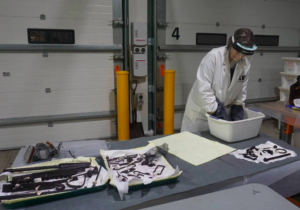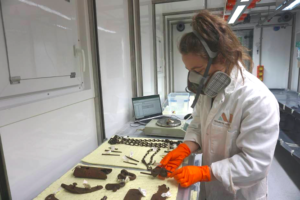Desalination Treatment of Iron Artefacts
Antarctic Heritage Trust Conservator Jane Hamill shows us the process of desalination of iron artefacts from Shackleton’s hut at Cape Royds and Scott’s hut at Cape Evans
The conservation team at Scott Base have been working through hundreds of artefacts from Shackleton’s hut at Cape Royds and Scott’s hut at Cape Evans.
The huts are located on the coast and for much of the year the sea is frozen, but for a few months over Summer the sea-ice breaks out and there is open water in front of the huts.
Hanging the artefacts in a container of alkaline solution for desalination (Jane Hamill/AHT)
The seawater causes deterioration of many materials. Metals in particular corrode, or rust, heavily in this environment. To slow the corrosion process the winter team are conserving nearly 200 iron artefacts using a treatment called desalination.
The artefacts are placed in containers with an alkaline solution for several weeks to wash out salts. After two months of regular monitoring, the artefacts are no longer releasing salts, so the desalination is complete.
The team are now removing the artefacts for the next stages of treatment. The first stage is to wash and dry them thoroughly. The iron is then treated with tannic acid to form a stable, passive surface, followed by coatings of acrylic resin and wax to protect the surface from moisture.
Once treatment is complete, the artefacts are photographed and treatments documented. They are then packed up for safe transport back to the huts this coming summer.
Belinda applying a protective coating to artefacts after drying (Shannah Rhynard-Geil/AHT)
Shannah checking weight change in the artefacts to monitor drying after desalination (Jane Hamill/AHT)






